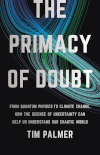- About MAA
- Membership
- MAA Publications
- Periodicals
- Blogs
- MAA Book Series
- MAA Press (an imprint of the AMS)
- MAA Notes
- MAA Reviews
- Mathematical Communication
- Information for Libraries
- Author Resources
- Advertise with MAA
- Meetings
- Competitions
- Programs
- Communities
- MAA Sections
- SIGMAA
- MAA Connect
- Students
- MAA Awards
- Awards Booklets
- Writing Awards
- Teaching Awards
- Service Awards
- Research Awards
- Lecture Awards
- Putnam Competition Individual and Team Winners
- D. E. Shaw Group AMC 8 Awards & Certificates
- Maryam Mirzakhani AMC 10 A Awards & Certificates
- Two Sigma AMC 10 B Awards & Certificates
- Jane Street AMC 12 A Awards & Certificates
- Akamai AMC 12 B Awards & Certificates
- High School Teachers
- News
You are here
The Primacy of Doubt

Publisher:
Basic Books
Publication Date:
2022
Number of Pages:
320
Format:
Hardcover
Price:
30.00
ISBN:
978-1541619715
Category:
General
[Reviewed by , on ]
David Aldous
08/23/2022
The author is a mathematical physicist, a distinguished leader in ensemble forecasting for weather prediction and climate forecasting. Paraphrasing Wikipedia, this means
instead of making a single forecast of the most likely weather, a set (or ensemble) of forecasts is produced. The multiple simulations are conducted to account for the two usual sources of uncertainty in forecast models:
- The errors introduced by the use of imperfect initial conditions, amplified by the chaotic nature of the evolution equations of the atmosphere
- Errors introduced because of imperfections in the model formulation. This approach can be used to make probabilistic forecasts of any dynamical system.
The writing style is on the "serious" side of popular science exposition, clear and well-written throughout, with the usual amount of topic history attached.
As to content, the centerpiece of this book is the discussion of weather forecasting (Chapter 5) and climate modeling (Chapter 6). These are exemplars of valuable clear and interesting exposition by an expert. However, the general theme of the book is that "chaos" equations are ubiquitous and provide a broad foundation for a "science of uncertainty" in which ensemble methods provide useful predictions. Well, undoubtedly there are examples, but those discussed in the book are unconvincing to me. Pandemics (Chapter 7) can certainly be modeled by nonlinear equations, but chaos is hardly relevant as an alternative to classical stochastic models, under which one can use the same scheme of multiple simulations under different models. See an excellent recent book by an actual epidemiologist, The Rules of Contagion by Adam Kucharski.
Aside from this core material, Chapters 1-3 give an amiable but rather standard account of chaos and fractals. Chapters 4 and 11 on quantum uncertainty, Chapter 8 on financial crises, Chapter 9 on regional conflicts, Chapter 10 on cost-loss models and Chapter 12 on "noisy brains" seem rather speculative and artificially forced into the author's basic theme.
From my own "probability in the real world" background, presenting this material as a "science of uncertainty" strikes me as very misleading. My starting question is "In what real world contexts of uncertainty -- where we might use words like "likely" or "unlikely" -- is it both practical and useful to attempt to estimate numerical probabilities?" There are contexts for individuals (your lifetime, your retirement stock portfolio, your happiness if you marry this person), contexts for societies (future geopolitics, economics, wars, governments) and science contexts. But in my mental list of 100 representative contexts, only a small handful of science contexts fit the "chaos" template. For forecasting important matters in the human world, research sponsored by IARPA in the late 2010s combined machine learning with human judgment, and this would be my prediction for an actual future "science of uncertainty".
On the positive side, reading speculation like this by a first-rate scientist is interesting in itself, as food for thought. For the MAA audience there is hardly any actual mathematics beyond the standard accounts of chaos and fractals, but it is good to see a creative mind at work, and his arguments may be more convincing to younger minds than mine who do not already have their own viewpoints.
David Aldous (www.stat.berkeley.edu/~aldous) is retired from U.C. Berkeley after 39 years but retains interests in theoretical and applied probability and in the popular exposition of probability in the real world.
See the publisher's website.
- Log in to post comments




